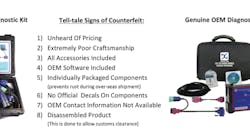Counterfeit scan tools are flooding the market at an alarming rate. The United States government is beginning to recognize the need to deal with this issue after many years of hard fought struggles lead by automotive OEMs, tool and equipment manufacturers and the commercial vehicle industry.
“Counterfeit tools are copies made with intent to defraud the buyer and come with several risks: misdiagnosis, quality, safety, warranty, support and full loss of the purchase price when the tool fails,” said Bob Stewart, manager of aftermarket service support for General Motors, in his presentation at the Fall 2013 General Meeting of the National Automotive Service Task Force (NASTF), held during the AAPEX/SEMA trade shows in Las Vegas in early November last year.
No Product Support
There is nothing good about counterfeit diagnostic equipment penetrating the global market. The bulk of counterfeit scan tools and diagnostic adapters are coming out of the Asia-Pacific region, primarily China.
A little online research will show hundreds of websites littered with products claiming to be OEM tools. Yet in reality, purchasers are receiving knock-off tools with no product support and extremely poor quality.
Tool manufacturers and OEMs know how to spot counterfeit tools and it’s almost guaranteed that the purchaser will not receive support for any counterfeit tool, usually when they need it most.
Unfortunately, online businesses in the U.S. are also jumping on the counterfeit resale bandwagon, making it even more difficult for the purchaser to know exactly what they’re buying.
Many highly recognized online websites host counterfeit tool sales. The number of counterfeit scan tools and adapters advertised on these sites is incomprehensible, yet many of these websites are ignorant to the fact that they are promoting counterfeit tools.
Costs
Costs associated with counterfeit tools vary widely. A majority of tools are being sold with add-on software, cables and accessories at no additional cost, making a purchaser’s eyes light up. A closer look at the product will reveal the untold truths about what they would actually be getting.
It’s been stated many times before: “If it sounds too good to be true, it probably is.”
It’s highly recommended that purchasers call the tool manufacturer prior to purchasing diagnostic tools to understand what is being bought and that the product is indeed the Real McCoy.
OEM Observations
Many tool manufacturers have spoken out about this issue. Here are a few comments from some of the leading tool manufacturers who are actively dealing with this issue.
- It’s a challenging task for industry experts to deal with counterfeit tools infesting the market. To add to the frustration, the level of tech support complaints and warranty claims is rising because the tools don’t perform as expected.
People are also becoming increasingly confident in making large purchases only because of the convenience it offers. If the website displays what they want to see, the product is as good as sold because counterfeiters do an exceptional job of copying OEM information word for word from the OEM website.
- Counterfeit tool makers and resellers have one goal in mind: get the money in any way possible. It’s challenging for customer service and tech support departments to tell technicians they bought a counterfeit tool without support or a warranty.
Even though it’s not the fault of the tool manufacturer, the technician is put in a bad position when trying to perform daily job functions.
- There is no way counterfeit products could come with an OEM warranty because the product wasn’t built by the original tool manufacturer.
The purchaser must contact the company they bought the tool from, provided they can find a contact number. If the purchaser actually gets to talk to someone who speaks their language, it is likely that they will answer any of the technician’s questions by simply reading the plagiarized information right from the OEM website.
Some Counsel
A bit of advice: Before purchasing the next greatest diagnostic tool, make sure to check the legitimacy of the manufacturer that makes it. Call the OEM and get a feel for who they are and verify their list of authorized online resellers.
When purchasing a tool from a website that’s not the manufacturer’s, contact the website owner you wish to purchase from to get the product’s specific serial number. Then, contact the OEM to make sure that the identification number can be identified by the OEM to make certain the unit is just being resold, rather than being a counterfeit.
These tips will help scan tool purchasers become confident that they are buying an authentic product that will function as expected, be technically supported and under warranty – the Real McCoy.
Brandon Montney is a senior sales and marketing specialist with DG Technologies – a vehicle network solutions company providing product, education, consulting and custom solutions (www.dgtech.com). He has more than 25 years of experience in marketing communications and customer relations serving the automotive, service body and commercial vehicle industries.



